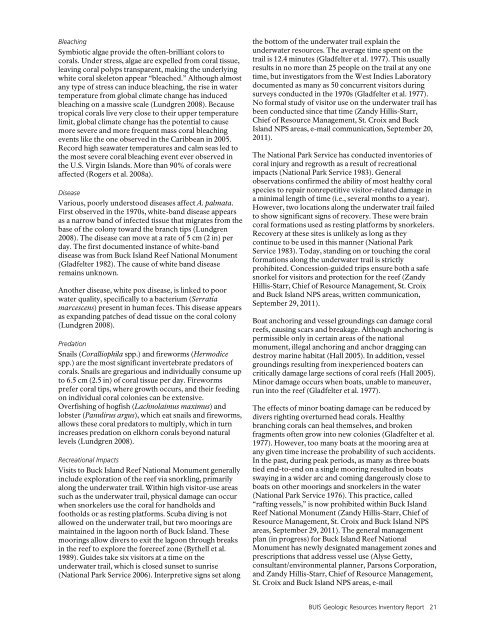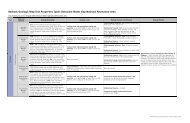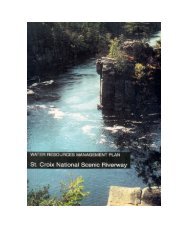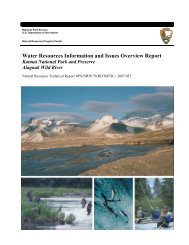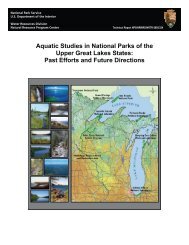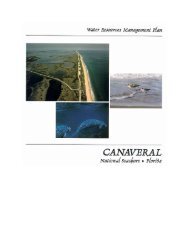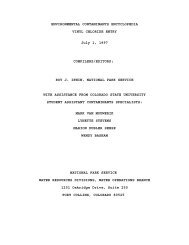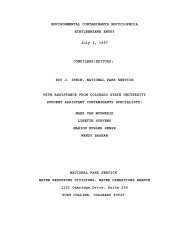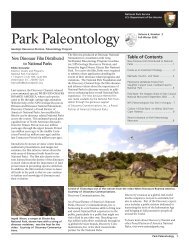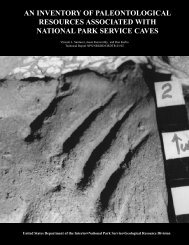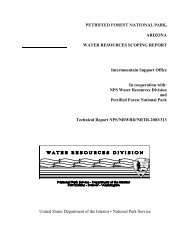Buck Island Reef National Monument Geologic Resources Inventory
Buck Island Reef National Monument Geologic Resources Inventory
Buck Island Reef National Monument Geologic Resources Inventory
You also want an ePaper? Increase the reach of your titles
YUMPU automatically turns print PDFs into web optimized ePapers that Google loves.
Bleaching<br />
Symbiotic algae provide the often-brilliant colors to<br />
corals. Under stress, algae are expelled from coral tissue,<br />
leaving coral polyps transparent, making the underlying<br />
white coral skeleton appear “bleached.” Although almost<br />
any type of stress can induce bleaching, the rise in water<br />
temperature from global climate change has induced<br />
bleaching on a massive scale (Lundgren 2008). Because<br />
tropical corals live very close to their upper temperature<br />
limit, global climate change has the potential to cause<br />
more severe and more frequent mass coral bleaching<br />
events like the one observed in the Caribbean in 2005.<br />
Record high seawater temperatures and calm seas led to<br />
the most severe coral bleaching event ever observed in<br />
the U.S. Virgin <strong>Island</strong>s. More than 90% of corals were<br />
affected (Rogers et al. 2008a).<br />
Disease<br />
Various, poorly understood diseases affect A. palmata.<br />
First observed in the 1970s, white-band disease appears<br />
as a narrow band of infected tissue that migrates from the<br />
base of the colony toward the branch tips (Lundgren<br />
2008). The disease can move at a rate of 5 cm (2 in) per<br />
day. The first documented instance of white-band<br />
disease was from <strong>Buck</strong> <strong>Island</strong> <strong>Reef</strong> <strong>National</strong> <strong>Monument</strong><br />
(Gladfelter 1982). The cause of white band disease<br />
remains unknown.<br />
Another disease, white pox disease, is linked to poor<br />
water quality, specifically to a bacterium (Serratia<br />
marcescens) present in human feces. This disease appears<br />
as expanding patches of dead tissue on the coral colony<br />
(Lundgren 2008).<br />
Predation<br />
Snails (Coralliophila spp.) and fireworms (Hermodice<br />
spp.) are the most significant invertebrate predators of<br />
corals. Snails are gregarious and individually consume up<br />
to 6.5 cm (2.5 in) of coral tissue per day. Fireworms<br />
prefer coral tips, where growth occurs, and their feeding<br />
on individual coral colonies can be extensive.<br />
Overfishing of hogfish (Lachnolaimus maximus) and<br />
lobster (Panulirus argus), which eat snails and fireworms,<br />
allows these coral predators to multiply, which in turn<br />
increases predation on elkhorn corals beyond natural<br />
levels (Lundgren 2008).<br />
Recreational Impacts<br />
Visits to <strong>Buck</strong> <strong>Island</strong> <strong>Reef</strong> <strong>National</strong> <strong>Monument</strong> generally<br />
include exploration of the reef via snorkling, primarily<br />
along the underwater trail. Within high visitor-use areas<br />
such as the underwater trail, physical damage can occur<br />
when snorkelers use the coral for handholds and<br />
footholds or as resting platforms. Scuba diving is not<br />
allowed on the underwater trail, but two moorings are<br />
maintained in the lagoon north of <strong>Buck</strong> <strong>Island</strong>. These<br />
moorings allow divers to exit the lagoon through breaks<br />
in the reef to explore the forereef zone (Bythell et al.<br />
1989). Guides take six visitors at a time on the<br />
underwater trail, which is closed sunset to sunrise<br />
(<strong>National</strong> Park Service 2006). Interpretive signs set along<br />
the bottom of the underwater trail explain the<br />
underwater resources. The average time spent on the<br />
trail is 12.4 minutes (Gladfelter et al. 1977). This usually<br />
results in no more than 25 people on the trail at any one<br />
time, but investigators from the West Indies Laboratory<br />
documented as many as 50 concurrent visitors during<br />
surveys conducted in the 1970s (Gladfelter et al. 1977).<br />
No formal study of visitor use on the underwater trail has<br />
been conducted since that time (Zandy Hillis-Starr,<br />
Chief of Resource Management, St. Croix and <strong>Buck</strong><br />
<strong>Island</strong> NPS areas, e-mail communication, September 20,<br />
2011).<br />
The <strong>National</strong> Park Service has conducted inventories of<br />
coral injury and regrowth as a result of recreational<br />
impacts (<strong>National</strong> Park Service 1983). General<br />
observations confirmed the ability of most healthy coral<br />
species to repair nonrepetitive visitor-related damage in<br />
a minimal length of time (i.e., several months to a year).<br />
However, two locations along the underwater trail failed<br />
to show significant signs of recovery. These were brain<br />
coral formations used as resting platforms by snorkelers.<br />
Recovery at these sites is unlikely as long as they<br />
continue to be used in this manner (<strong>National</strong> Park<br />
Service 1983). Today, standing on or touching the coral<br />
formations along the underwater trail is strictly<br />
prohibited. Concession-guided trips ensure both a safe<br />
snorkel for visitors and protection for the reef (Zandy<br />
Hillis-Starr, Chief of Resource Management, St. Croix<br />
and <strong>Buck</strong> <strong>Island</strong> NPS areas, written communication,<br />
September 29, 2011).<br />
Boat anchoring and vessel groundings can damage coral<br />
reefs, causing scars and breakage. Although anchoring is<br />
permissible only in certain areas of the national<br />
monument, illegal anchoring and anchor dragging can<br />
destroy marine habitat (Hall 2005). In addition, vessel<br />
groundings resulting from inexperienced boaters can<br />
critically damage large sections of coral reefs (Hall 2005).<br />
Minor damage occurs when boats, unable to maneuver,<br />
run into the reef (Gladfelter et al. 1977).<br />
The effects of minor boating damage can be reduced by<br />
divers righting overturned head corals. Healthy<br />
branching corals can heal themselves, and broken<br />
fragments often grow into new colonies (Gladfelter et al.<br />
1977). However, too many boats at the mooring area at<br />
any given time increase the probability of such accidents.<br />
In the past, during peak periods, as many as three boats<br />
tied end-to-end on a single mooring resulted in boats<br />
swaying in a wider arc and coming dangerously close to<br />
boats on other moorings and snorkelers in the water<br />
(<strong>National</strong> Park Service 1976). This practice, called<br />
“rafting vessels,” is now prohibited within <strong>Buck</strong> <strong>Island</strong><br />
<strong>Reef</strong> <strong>National</strong> <strong>Monument</strong> (Zandy Hillis-Starr, Chief of<br />
Resource Management, St. Croix and <strong>Buck</strong> <strong>Island</strong> NPS<br />
areas, September 29, 2011). The general management<br />
plan (in progress) for <strong>Buck</strong> <strong>Island</strong> <strong>Reef</strong> <strong>National</strong><br />
<strong>Monument</strong> has newly designated management zones and<br />
prescriptions that address vessel use (Alyse Getty,<br />
consultant/environmental planner, Parsons Corporation,<br />
and Zandy Hillis-Starr, Chief of Resource Management,<br />
St. Croix and <strong>Buck</strong> <strong>Island</strong> NPS areas, e-mail<br />
BUIS <strong>Geologic</strong> <strong>Resources</strong> <strong>Inventory</strong> Report 21


